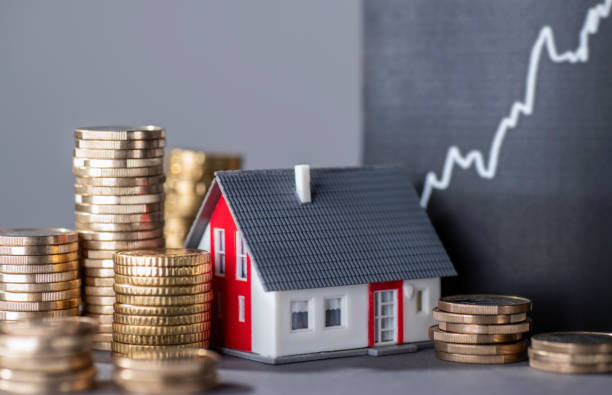
Picture this scenario: it's Sunday lunch, and your 25-year-old grandson mentions he's booked a week in Thailand. Cue the familiar tsk-tsk sound and the knowing look that says 'no wonder you can't afford a deposit.'
But here's the thing that might surprise you—the maths behind that assumption simply doesn't stack up anymore.
In 2025, the average Australian property costs 9.4 times the average Australian's annual income. Back in 1984, that same ratio was just 3.3 times.
This isn't just a minor shift—it's a complete transformation of what it means to save for a home in Australia.
When houses were genuinely within reach
Let's wind the clock back to 1984, when many of today's grandparents were establishing themselves. The average Australian home cost around $64,000, and a 20 per cent deposit required $12,807—equivalent to about 66 per cent of one year's income.
Fast-forward to today, and that deposit story looks dramatically different. With average homes now costing $990,448, a 20 per cent deposit requires $198,089—that's 189 per cent of one year's income, or nearly two full years of salary saved entirely for a deposit.
'In 1984, a 20 per cent deposit was 66 per cent of one year's income. Today, it's 189 per cent'
The travel paradox
Here's where the story gets really interesting. While housing costs have skyrocketed, international travel has become remarkably affordable in relative terms.
That flight to Los Angeles that cost around $1,400 in 1988? You can still find similar flights for roughly the same price today—sometimes even cheaper.
But when that 1988 flight represented about 3 per cent of a typical home purchase, today it's closer to 0.2 per cent.
A week in Bali that might have cost $349 in 1980—representing 1 per cent of a home purchase—now costs around $700 but represents just 0.1 per cent of today's property prices.
With median weekly earnings now at $1,396, a young Australian can afford that Bali trip with roughly two weeks' salary. In 1980, it would have taken several weeks of the average wage.
What's actually breaking the budget
While young Australians cop criticism for their travel habits, the real budget-busters are far more mundane—and unavoidable.
The average national loan size for owner-occupied dwellings has reached $678,000, with monthly repayments that would have seemed impossible to previous generations.
But it's not just housing. The costs that have truly exploded are the basics: insurance premiums that can easily run into thousands annually, dining out that can cost $100+ for a couple at the pub, and utilities that take ever-larger chunks of weekly pay packets.
Housing affordability then vs now
1984: Average home cost 3.3x annual income
2025: Average home costs 9.4x annual income
1984: 20 per cent deposit = 66 per cent of annual income
2025: 20 per cent deposit = 189 per cent of annual income
Sources: Australian Bureau of Statistics, Finder.com.au
The generational divide explained
This dramatic shift helps explain why conversations about money and priorities can feel so frustrating between generations. What looks like frivolous spending to older Australians often represents the only affordable luxury left to younger ones.
Those who purchased homes in the early to mid-1980s enjoyed incredible increases in property values, building wealth simply by owning their home.
Today's young adults face the opposite scenario—watching house prices outpace their saving capacity year after year.
Australia's real wages are currently 4.8 per cent lower than pre-pandemic levels, while across the OECD, real wages have risen 1.5 per cent on average.
This means young Australians aren't just facing higher housing costs—they're doing so with relatively less purchasing power than their parents had.
Regional realities offer hope
The national figures tell only part of the story. Regional areas across Australia show a combined median house price of $708,956, significantly more accessible than capital city prices.
Cities like Adelaide, with a median house price of $906,620, still offer relatively affordable entry points, though even these have surged 76.7 per cent over the past five years.
Perth experienced a 24 per cent annual increase despite remaining more affordable than eastern capitals, while Hobart and Darwin remain the most affordable capital cities.
What's really expensive now vs then
- Housing: 15-30x more expensive (relative to income)
- International flights: Roughly the same price
- Insurance: Dramatically more expensive
- Dining out: Significantly more expensive
- Basic utilities: Much higher proportion of income
The interest rate reality
It's worth acknowledging that previous generations faced interest rates as high as 17 per cent in the early 1980s, compared to today's rates around 6 per cent.
However, even factoring in those higher rates, buyers in the 1980s saved smaller deposits, borrowed less, and still spent much less as a proportion of their incomes.
The lower interest rates of recent decades, rather than making housing more affordable, simply pushed prices higher as buyers could borrow more.
Understanding, not judgment
None of this is to diminish the genuine financial discipline that previous generations demonstrated, or to suggest that budgeting and saving aren't important for today's young adults.
Rather, it's about recognising that the economic landscape has fundamentally changed. A week in Bali isn't preventing anyone from buying a house—the structural changes in housing affordability are doing that all on their own.
Perhaps the real conversation we need to be having isn't about avocado toast or overseas holidays, but about how we can work together across generations to address Australia's housing affordability crisis.
What conversations are you having with younger family members about housing and finances? Have you noticed this shift in what's affordable and what isn't? Share your thoughts and experiences below—these discussions are how we build understanding across the generations.
Original Article
https://au.finance.yahoo.com/news/a...people-frighteningly-expensive-190054175.html
Buying a house in the 80s versus today [2025 update] | Finder
Cited text: Today, the average Australian property costs the average Australian 9.4 times their annual income.
Excerpt: In 2025, the average Australian property costs 9.4 times the average Australian's annual income.
https://www.finder.com.au/buy-a-house/owning-a-home-in-the-80s-vs-today
Buying a house in the 80s versus today [2025 update] | Finder
Cited text: In 1984 the average home cost 3.3 times the average income.
Excerpt: In 2025, the average Australian property costs 9.4 times the average Australian's annual income.
https://www.finder.com.au/buy-a-house/owning-a-home-in-the-80s-vs-today
Buying a house in the 80s versus today [2025 update] | Finder
Cited text: If the average home cost $64,039... A 20 per cent deposit equalled $12,807.
Excerpt: The average Australian home cost around $64,000, and a 20 per cent deposit required $12,807—equivalent to about 66 per cent of one year's income
https://www.finder.com.au/buy-a-house/owning-a-home-in-the-80s-vs-today
Buying a house in the 80s versus today [2025 update] | Finder
Cited text: In 1984, a 20 per cent deposit was 66 per cent of one year's income.
Excerpt: The average Australian home cost around $64,000, and a 20 per cent deposit required $12,807—equivalent to about 66 per cent of one year's income
https://www.finder.com.au/buy-a-house/owning-a-home-in-the-80s-vs-today
Buying a house in the 80s versus today [2025 update] | Finder
Cited text: If the average home cost $990,448... A 20 per cent deposit equals $198,089.
Excerpt: With average homes now costing $990,448, a 20 per cent deposit requires $198,089—that's 189 per cent of one year's income, or nearly two full years of salary saved entirely for a deposit
https://www.finder.com.au/buy-a-house/owning-a-home-in-the-80s-vs-today
Buying a house in the 80s versus today [2025 update] | Finder
Cited text: Today, it's 189 per cent. It would take you almost 2 whole years' of income to save a 20 per cent deposit today.
Excerpt: With average homes now costing $990,448, a 20 per cent deposit requires $198,089—that's 189 per cent of one year's income, or nearly two full years of salary saved entirely for a deposit
https://www.finder.com.au/buy-a-house/owning-a-home-in-the-80s-vs-today
Employee earnings, August 2024 | Australian Bureau of Statistics
Cited text: · In August 2024, median weekly earnings for employees was $1,396, up $96 from $1,300 in August 2023.
Excerpt: With median weekly earnings now at $1,396
https://www.abs.gov.au/statistics/l...g-conditions/employee-earnings/latest-release
Australia's Residential Property Market Analysis 2025
Cited text: As of June 2025, the ABS data showed the average national loan size for owner-occupied dwellings had risen to AUD 678,000 (USD 434,000), with New Sout...
Excerpt: The average national loan size for owner-occupied dwellings has reached $678,000
https://www.globalpropertyguide.com/pacific/australia/price-history
Comparing the Affordability of Australian Property Over Decades
Cited text: If you purchased a home in the early to mid-1980s, you’ve enjoyed an incredible increase in the value of your property. But if you’re trying to buy yo...
Excerpt: Those who purchased homes in the early to mid-1980s enjoyed incredible increases in property values
https://www.altusfinancial.com.au/b...rdability-of-australian-property-over-decades
Why real wages in Australia have fallen—The University of Sydney
Cited text: Australia’s real wages are 4.8 per cent lower than pre-pandemic levels while across the OECD real wages over the same period have, on average, risen 1.5 per cent.
Excerpt: Australia's real wages are currently 4.8 per cent lower than pre-pandemic levels, while across the OECD, real wages have risen 1.5 per cent on average
https://www.sydney.edu.au/news-opinion/news/2024/07/12/why-real-wages-in-australia-have-fallen.html
Median house prices around Australia: September 2025
Cited text: In contrast, the combined median house price for regional areas across the country is $708,956, reflecting more affordable options outside of major me...
Excerpt: Regional areas across Australia show a combined median house price of $708,956
https://www.yourmortgage.com.au/compare-home-loans/median-house-prices-around-australia
Median house prices around Australia: September 2025
Cited text: Greater Adelaide's property market remains strong, with a median house price of $906,620 and a median unit price of $620,421. Combined, the city's med...
Excerpt: Cities like Adelaide, with a median house price of $906,620, still offer relatively affordable entry points, though even these have surged 76.7 per cent over the past five years
https://www.yourmortgage.com.au/compare-home-loans/median-house-prices-around-australia
Australia: residential property value 2024 | Statista
Cited text: Notably, Perth experienced the most significant annual increase in its average residential property value, with a 24 percent increase from October 202...
Excerpt: Perth experienced a 24 per cent annual increase despite remaining more affordable than eastern capitals, while Hobart and Darwin remain the most affordable capital cities
https://www.statista.com/statistics/1030525/australia-residential-property-value/
Comparing the Affordability of Australian Property Over Decades
Cited text: · The fall in inflation led to lower nominal interest rates, particularly in the late 1980s, and the fall was dramatic, from about 17 per cent at the ...
Excerpt: previous generations faced interest rates as high as 17 per cent in the early 1980s, compared to today's rates around 6 per cent
https://www.altusfinancial.com.au/b...rdability-of-australian-property-over-decades
Comparing the Affordability of Australian Property Over Decades
Cited text: Unlike your parents or grandparents, you’re not dealing with interest rates of 17 per cent.
Excerpt: previous generations faced interest rates as high as 17 per cent in the early 1980s, compared to today's rates around 6 per cent
https://www.altusfinancial.com.au/b...rdability-of-australian-property-over-decades
Buying a house in the 80s versus today [2025 update] | Finder
Cited text: Buyers in the 1980s saved smaller deposits, borrowed less and had cheaper loans. Even when you factor in higher interest rates in the 80s people still...
Excerpt: even factoring in those higher rates, buyers in the 1980s saved smaller deposits, borrowed less, and still spent much less as a proportion of their incomes
https://www.finder.com.au/buy-a-house/owning-a-home-in-the-80s-vs-today







